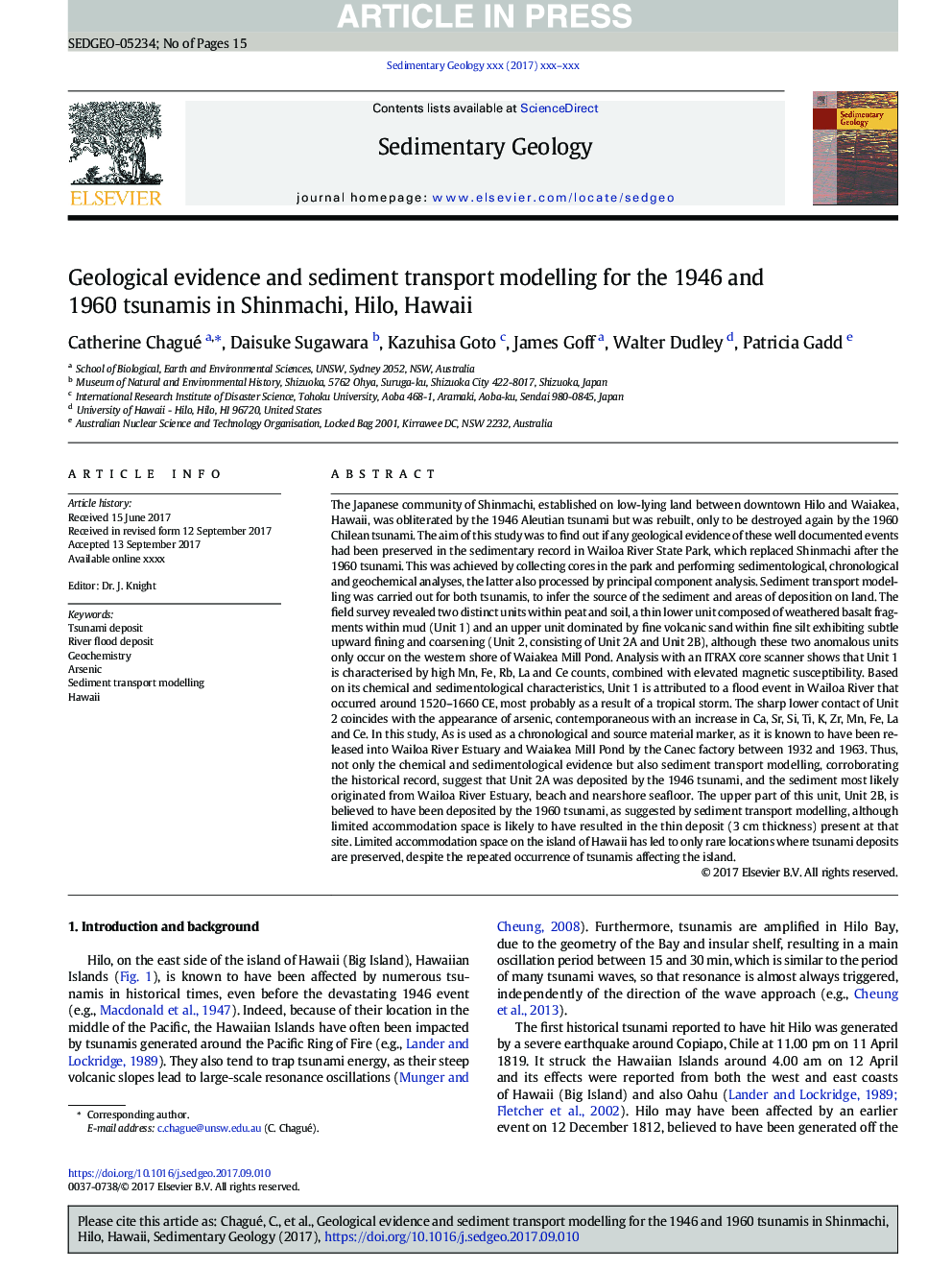| کد مقاله | کد نشریه | سال انتشار | مقاله انگلیسی | نسخه تمام متن |
|---|---|---|---|---|
| 8908561 | 1635999 | 2018 | 15 صفحه PDF | دانلود رایگان |
عنوان انگلیسی مقاله ISI
Geological evidence and sediment transport modelling for the 1946 and 1960 tsunamis in Shinmachi, Hilo, Hawaii
دانلود مقاله + سفارش ترجمه
دانلود مقاله ISI انگلیسی
رایگان برای ایرانیان
کلمات کلیدی
موضوعات مرتبط
مهندسی و علوم پایه
علوم زمین و سیارات
فرآیندهای سطح زمین
پیش نمایش صفحه اول مقاله

چکیده انگلیسی
The Japanese community of Shinmachi, established on low-lying land between downtown Hilo and Waiakea, Hawaii, was obliterated by the 1946 Aleutian tsunami but was rebuilt, only to be destroyed again by the 1960 Chilean tsunami. The aim of this study was to find out if any geological evidence of these well documented events had been preserved in the sedimentary record in Wailoa River State Park, which replaced Shinmachi after the 1960 tsunami. This was achieved by collecting cores in the park and performing sedimentological, chronological and geochemical analyses, the latter also processed by principal component analysis. Sediment transport modelling was carried out for both tsunamis, to infer the source of the sediment and areas of deposition on land. The field survey revealed two distinct units within peat and soil, a thin lower unit composed of weathered basalt fragments within mud (Unit 1) and an upper unit dominated by fine volcanic sand within fine silt exhibiting subtle upward fining and coarsening (Unit 2, consisting of Unit 2A and Unit 2B), although these two anomalous units only occur on the western shore of Waiakea Mill Pond. Analysis with an ITRAX core scanner shows that Unit 1 is characterised by high Mn, Fe, Rb, La and Ce counts, combined with elevated magnetic susceptibility. Based on its chemical and sedimentological characteristics, Unit 1 is attributed to a flood event in Wailoa River that occurred around 1520-1660Â CE, most probably as a result of a tropical storm. The sharp lower contact of Unit 2 coincides with the appearance of arsenic, contemporaneous with an increase in Ca, Sr, Si, Ti, K, Zr, Mn, Fe, La and Ce. In this study, As is used as a chronological and source material marker, as it is known to have been released into Wailoa River Estuary and Waiakea Mill Pond by the Canec factory between 1932 and 1963. Thus, not only the chemical and sedimentological evidence but also sediment transport modelling, corroborating the historical record, suggest that Unit 2A was deposited by the 1946 tsunami, and the sediment most likely originated from Wailoa River Estuary, beach and nearshore seafloor. The upper part of this unit, Unit 2B, is believed to have been deposited by the 1960 tsunami, as suggested by sediment transport modelling, although limited accommodation space is likely to have resulted in the thin deposit (3Â cm thickness) present at that site. Limited accommodation space on the island of Hawaii has led to only rare locations where tsunami deposits are preserved, despite the repeated occurrence of tsunamis affecting the island.
ناشر
Database: Elsevier - ScienceDirect (ساینس دایرکت)
Journal: Sedimentary Geology - Volume 364, February 2018, Pages 319-333
Journal: Sedimentary Geology - Volume 364, February 2018, Pages 319-333
نویسندگان
Catherine Chagué, Daisuke Sugawara, Kazuhisa Goto, James Goff, Walter Dudley, Patricia Gadd,